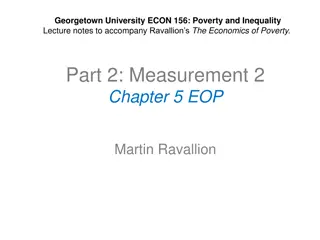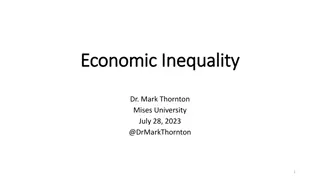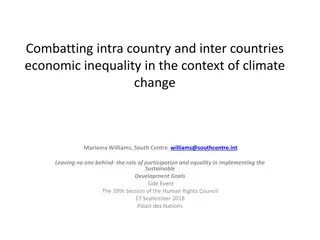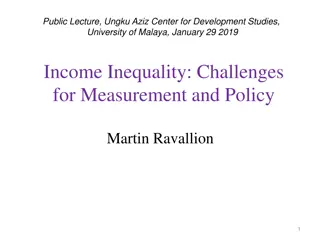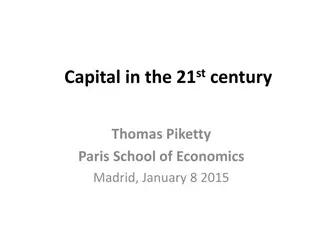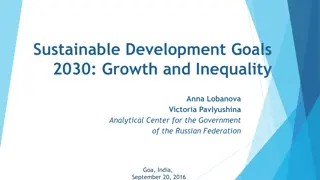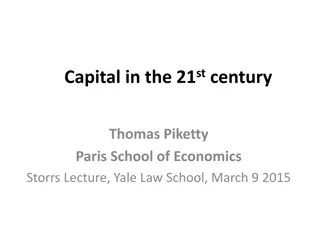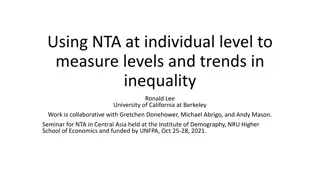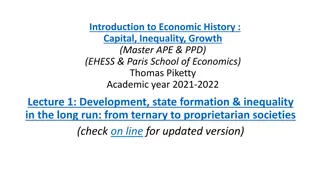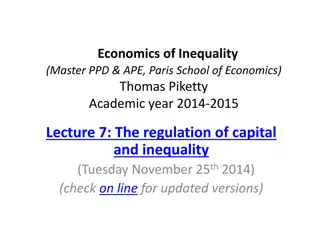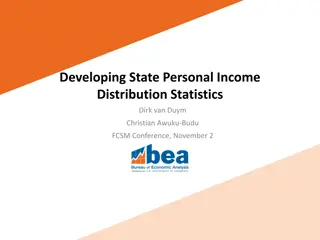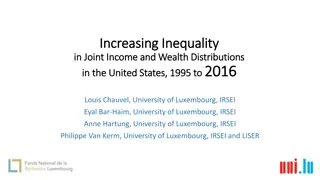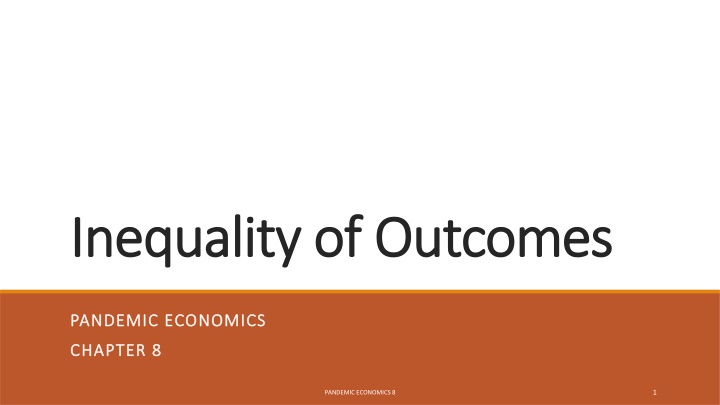
Pandemic Economics: Understanding Inequality of Health Outcomes
Explore the impact of inequality of health outcomes during a pandemic, discussing factors such as wealth, access to healthcare, and socioeconomic standing. Learn about the disparities in health outcomes between different socio-economic groups and the demand for healthcare.
Download Presentation

Please find below an Image/Link to download the presentation.
The content on the website is provided AS IS for your information and personal use only. It may not be sold, licensed, or shared on other websites without obtaining consent from the author. If you encounter any issues during the download, it is possible that the publisher has removed the file from their server.
You are allowed to download the files provided on this website for personal or commercial use, subject to the condition that they are used lawfully. All files are the property of their respective owners.
The content on the website is provided AS IS for your information and personal use only. It may not be sold, licensed, or shared on other websites without obtaining consent from the author.
E N D
Presentation Transcript
Inequality of Outcomes Inequality of Outcomes PANDEMIC ECONOMICS PANDEMIC ECONOMICS CHAPTER 8 CHAPTER 8 1 PANDEMIC ECONOMICS 8
Topics Topics 1. Inequality of Wealth Becomes Inequality of Health 2. Demand for Healthcare 3. Physician Factors 4. Demographic Characteristics 5. Health Status 6. Socioeconomic standing 7. Structural Inequality 2 PANDEMIC ECONOMICS 8
Learning Objectives Learning Objectives After reading this chapter, you will be able to: After reading this chapter, you will be able to: LO1 Explain why inequality of wealth becomes inequality of health. LO2 Discuss the components of the demand for healthcare. LO3 Analyze why physician factors impact the demand for healthcare. LO4 Describe how demographic characteristics impact the demand for healthcare. LO5 Assess the relationship between health status and the demand for healthcare. LO6 Address how socioeconomic standing impacts the demand for healthcare. LO7 Identify the relationship between structural inequality and the demand for healthcare 3 PANDEMIC ECONOMICS 10
A pandemic exposes disparities of health outcomes between socio-economic groups. 1. Inequality 1. Inequality of Wealth of Wealth Becomes Becomes Inequality of Inequality of Health Health With less access to healthcare, individuals in lower income classes or marginalized communities experience negative health outcomes at higher rates than other members of the population. Although no one has natural immunity to a new disease, socioeconomic and structural disparities demonstrate what happens when a pandemic is layered upon entrenched inequalities. 4 PANDEMIC ECONOMICS 8
Disadvantage Disadvantage Because of pre-existing medical conditions and less access to healthcare, those who are disadvantaged may experience infections at a higher rate than their percentage in the general population. During a pandemic, the working poor risk daily harmful health effects while those with higher socioeconomic status work from home. An inequality of health outcomes depends on precipitating events, the vulnerability of healthcare systems, and factors that determine the demand for healthcare. 5 PANDEMIC ECONOMICS 8
Economists treat health like other investments that enhance future productivity. Individuals have a level of health that depreciates with age. They invest in health because better health status leads to more time for both market and non-market activities. 2. Demand for 2. Demand for Healthcare Healthcare 6 PANDEMIC ECONOMICS 8
Health and Productivity Health and Productivity Improvements in health increase human capital, the knowledge and skills embodied in work effort that lead to the creation of economic value. But the allocation of resources to enhance health reduces the money available to purchase other goods and services, resulting in lower levels of current consumption. The implication is that better health will increase future productivity, income, and consumption. 7 PANDEMIC ECONOMICS 8
Model of Derived Demand Model of Derived Demand The model of derived demandprovides a framework. The demand for healthcare is derived from an individual s demand for health. It is inversely related to price. The demand for healthcare is defined in terms of what an individual is willing to sacrifice to obtain better health outcomes. 8 PANDEMIC ECONOMICS 8
Demand for Healthcare Demand for Healthcare Price of Healthcare DC1 D1 D1 demand for healthcare Qm minimum health standard for individuals DC1 guaranteed clinical quantity of care for each patient At a price of P0, quantity demanded = Q1 P0 Quantity of Healthcare Qm Q1 QC1 9 PANDEMIC ECONOMICS 8
Determinants of Demand Determinants of Demand The demand for healthcare is a function of both physician and patient factors. Physicians impact the demand for healthcare through their positions in the system. Physicians are both agents of their patients and providers of healthcare. By recommending additional care, physicians create demand for their own services. Patient factors include demographic characteristics, health status, socioeconomic standing, and structural inequities. 10 PANDEMIC ECONOMICS 8
The Demand for Healthcare The Demand for Healthcare For person j over time t, the demand for healthcare (HCjt) is written as a function of its determinants: HCjt = f(Pt, Djt, Hjt, Sjt, Ijt) Pt physician factors Djt demographic characteristics Hjt health status Sjt socioeconomic standing Ijt structural inequality 11 PANDEMIC ECONOMICS 8
Physicians impact the demand for healthcare in their roles as service providers and patient advisors. They admit patients to hospitals, diagnose illnesses, order tests, care for patients, administer treatments, and prescribe drugs. 3. Physician 3. Physician Factors Factors 12 PANDEMIC ECONOMICS 8
Principal Principal- -Agent Relationship Agent Relationship The physician-patient relationship is characterized as a principal- agent relationship, when an agent, the physician, is granted authority to make decisions for an individual, the principal. The relationship functions when they agree on treatment. If the interests of the principal and agent align, efficiencies exist. 13 PANDEMIC ECONOMICS 8
Adverse Selection and Moral Hazard Adverse Selection and Moral Hazard ADVERSE SELECTION MORAL HAZARD When one member of a transaction benefits from asymmetric information, distorting the market with a lack of shared information. If an individual assumes more risk when not bearing the entire cost of exposure to risk. 14 PANDEMIC ECONOMICS 8
Induced Demand Induced Demand Physicians may induce demand. One, physicians may be perfect agents, serving the interests of patients. Two, physicians may be imperfect agents, serving their own interests. In either case, physicians influence the demand for healthcare. 15 PANDEMIC ECONOMICS 8
Supplier Supplier- -Induced Demand Induced Demand When supply and demand are dependent, supplier-induced demand may exist. An increase in the supply of healthcare may raise healthcare expenditure per capita. Doctors, acting as agents for their patients, use their discretionary power to undertake demand-shifting activities. 16 PANDEMIC ECONOMICS 8
Price of Healthcare An increase in supply from S1 to S2 induces demand to increase from D1 to D2 D1 D2 S1 S2 a b Q1 Q2 Quantity of Healthcare 17 PANDEMIC ECONOMICS 8
Demand Demand- -Shifting Activities Shifting Activities Demand-shifting activities take the form of medical services and/or additional treatments. The practice includes two types of assistance: referrals (written orders by doctors to see specialists) and consultations (the act of seeking assistance from another healthcare provider for therapeutic interventions, diagnostic studies, or other forms of care). One motive for demand-shifting activities is self-interest: doctors seek to boost their incomes. But supply-induced demand may also result when physicians consider the well- being of patients. 18 PANDEMIC ECONOMICS 8
Interaction Between Physicians and Patients Interaction Between Physicians and Patients The potential for supplier-induced demand is a function of circumstance. If the patient has clear and observable characteristics and full information about treatment plans, while the physician s current income equals target income and acts in the best interest of the patient, no induced demand occurs. If the patient has several unobservable characteristics and is uninformed, while the physician s current income is less than target income and acts in self- interest, induced demand exists. Several other scenarios may occur. 19 PANDEMIC ECONOMICS 8
SUPPLY-SIDE FACTORS DEMAND-SIDE FACTORS Current income Target income Physician/population ratio Service price Payment method Consultation time Type of employment of physicians Observable physician characteristics Size and type of hospital Observable characteristics of patients Non-clinical characteristics of patients Insurance coverage 20 PANDEMIC ECONOMICS 8
Impact of a Pandemic Impact of a Pandemic A pandemic creates a unique challenge. In theory, flattening the epidemic curve allows hospitals to obtain additional equipment, boost capacity, and prepare for the onset of cases. The supply of healthcare increases. Demand inducement means a subsequent increase in demand: healthcare providers advise patients to consume more medical care. 21 PANDEMIC ECONOMICS 8
Demography is the study of the changing structure of human populations, including factors that shift the demand for healthcare: family structure labor force participation fertility migration population 4. 4. Demographic Demographic Characteristics Characteristics 22 PANDEMIC ECONOMICS 8
MIGRATION POPULATION As immigration increases, all else equal, the demand for healthcare decreases. At the aggregate level, rising population increases the demand for healthcare services. 23 PANDEMIC ECONOMICS 8
A change in health status shifts the demand for healthcare. In response to an accident, disease, illness, or injury, the demand for medical care (emergency visits, hospitalizations, outpatient visits) increases. Also, lifestyle choices impact demand. 5. Health 5. Health Status Status 24 PANDEMIC ECONOMICS 8
During a pandemic, as the disease spreads throughout a population, the demand for healthcare increases from D1 to D2 25 PANDEMIC ECONOMICS 8
A change in socioeconomic status shifts the demand for healthcare through education and income. Even though these variables are correlated, each may lead to a change in demand for healthcare. 6. 6. Socioeconomic Socioeconomic Standing Standing 26 PANDEMIC ECONOMICS 8
Education Education The quality and quantity of schooling impacts lifetime opportunity, employability, and earnings. During a pandemic, people of all ages must learn about health risks and disease outcomes from healthcare professionals and political leaders, who vary with respect to their abilities to convey information to the public. For individuals, a lack of knowledge and information during a pandemic may serve as a barrier to effective behavior. 27 PANDEMIC ECONOMICS 8
Income Income Income is linked to both educational attainment and healthcare outcomes. When disease spreads during a pandemic, children below the poverty line face several challenges. Classrooms close, hunger rises, and parental stress increases. 28 PANDEMIC ECONOMICS 8
Socioeconomic Gradients in Health Socioeconomic Gradients in Health Those with higher incomes and levels of education experience better health outcomes. Gradients in income and education exist for racial and ethnic groups, measured by life expectancy, mortality, and other health indicators. Causal pathways lead to specific health outcomes, although the results vary across indicators, depending on age, historical period, gender, geographic location, life stage, nativity, and race. 29 PANDEMIC ECONOMICS 8
The Need for Targeted Policies The Need for Targeted Policies The existence of socioeconomic gradients suggests the need for targeted policies that reduce health disparities. Gradient patterns reveal disparities across the socioeconomic spectrum, not just those with the least privilege. From an ethical standpoint, it may be unacceptable for some members of a society to experience inferior health outcomes. 30 PANDEMIC ECONOMICS 8
Structural inequality refers to the condition in which some members of a population receive unequal status relative to others. A society may perpetuate this arrangement through its decisions, opportunities, rights, and roles. 7. Structural 7. Structural Inequality Inequality Structural inequalities are observed in institutions such as the economy, education, law, and healthcare. They result from an economic and political imbalance of power. 31 PANDEMIC ECONOMICS 8
Sources of Inequality Sources of Inequality In mixed economies, inequality of outcomes occurs because capabilities, circumstances, knowledge, motivation, and skills are unequally distributed. These factors impact lifetime opportunities, employment, and earnings. The market places a higher value on human capital, so inequality of outcomes rises in societies that do not provide these characteristics for everyone. 32 PANDEMIC ECONOMICS 8
The Role of Income The Role of Income With structural inequality, income plays an important role. Families in lower income quintiles do not have the same access to healthcare services. The existence of a job does not guarantee access to a healthcare network. Lower levels of real income and living standards decrease health status because markets do not work for everyone and political systems may not correct market failures such as inequity. 33 PANDEMIC ECONOMICS 8
The Role of Discrimination The Role of Discrimination An important source of inequality is racial and sexual discrimination, the behaviors, policies, and practices that perpetuate inequalities between groups. Due to discriminatory practices, women and those with minority status face additional challenges. For women, labor market discrimination may lead to different wages and employment opportunities. Marginalized members of a population may experience overcrowded housing, environmental hazards, and lower levels of air quality. During a pandemic, marginalized groups are more likely to have types of employment that limit their ability to quarantine. 34 PANDEMIC ECONOMICS 8
Intersectionality Intersectionality Intersectionality the interconnected nature of social categorizations such as ethnicity, gender, race, and sex provides a framework to assess the experience of people with multiple areas of marginalized status. By addressing how inequality and power manifest themselves through racism and sexism and the ways in which they are linked, intersectionality highlights the experiences of all people, not just those who benefit most from the existing order. Intersectionality reveals how inequality and power and their interlocking dynamics are structured for different members of a population, especially oppressed groups. 35 PANDEMIC ECONOMICS 8
Health Risks from Structural Inequality Health Risks from Structural Inequality A pandemic reveals disproportionate health risk from structural inequality at the intersection of class, ethnicity, race, and occupation. Many frontline jobs deemed essential offer lower pay and higher risk and are staffed by members of the population at the most marginalized intersections. A pandemic also exposes inequality with respect to healthcare outcomes. 36 PANDEMIC ECONOMICS 8
Health Justice Health Justice This analysis of structural inequality exists in a framework of health justice: the correlation between health outcomes on one hand and income, race/ethnicity, and sex on the other. Health justice provides a method to use laws, policies, and regulations to eliminate health disparities. In a pandemic, a framework of health justice offers a policy toolkit. The objective is to provide access to healthcare resource for all people, even those with multiple non-dominant forms of identity. 37 PANDEMIC ECONOMICS 8


